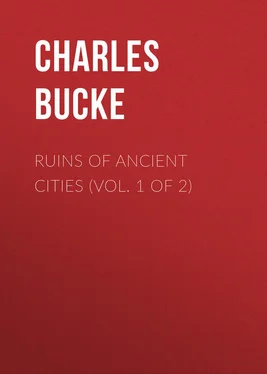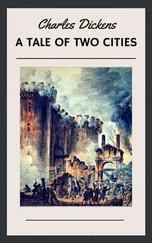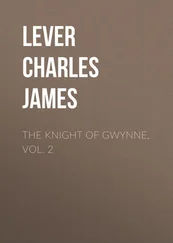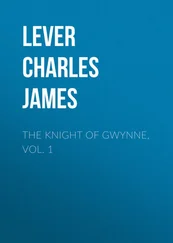Charles Bucke - Ruins of Ancient Cities (Vol. 1 of 2)
Здесь есть возможность читать онлайн «Charles Bucke - Ruins of Ancient Cities (Vol. 1 of 2)» — ознакомительный отрывок электронной книги совершенно бесплатно, а после прочтения отрывка купить полную версию. В некоторых случаях можно слушать аудио, скачать через торрент в формате fb2 и присутствует краткое содержание. Жанр: foreign_antique, foreign_prose, на английском языке. Описание произведения, (предисловие) а так же отзывы посетителей доступны на портале библиотеки ЛибКат.
- Название:Ruins of Ancient Cities (Vol. 1 of 2)
- Автор:
- Жанр:
- Год:неизвестен
- ISBN:нет данных
- Рейтинг книги:4 / 5. Голосов: 1
-
Избранное:Добавить в избранное
- Отзывы:
-
Ваша оценка:
- 80
- 1
- 2
- 3
- 4
- 5
Ruins of Ancient Cities (Vol. 1 of 2): краткое содержание, описание и аннотация
Предлагаем к чтению аннотацию, описание, краткое содержание или предисловие (зависит от того, что написал сам автор книги «Ruins of Ancient Cities (Vol. 1 of 2)»). Если вы не нашли необходимую информацию о книге — напишите в комментариях, мы постараемся отыскать её.
Ruins of Ancient Cities (Vol. 1 of 2) — читать онлайн ознакомительный отрывок
Ниже представлен текст книги, разбитый по страницам. Система сохранения места последней прочитанной страницы, позволяет с удобством читать онлайн бесплатно книгу «Ruins of Ancient Cities (Vol. 1 of 2)», без необходимости каждый раз заново искать на чём Вы остановились. Поставьте закладку, и сможете в любой момент перейти на страницу, на которой закончили чтение.
Интервал:
Закладка:
"On arriving at Alexandria," says Mr. Wilkinson, "the traveller naturally enquires where are the remains of that splendid city, which was second only to Rome itself, and whose circuit of fifteen miles contained a population of three hundred thousand inhabitants and an equal number of slaves; and where the monuments of its former greatness? He has heard of Cleopatra's Needle and Pompey's Pillar, from the days of his childhood, and the fame of its library, the Pharos, the temple of Serapis and of those philosophers and mathematicians, whose venerable names contribute to the fame of Alexandria, even more than the extent of its commerce or the splendour of the monuments, that once adorned it, are fresh in his recollection; – and he is surprised, in traversing mounds which mark the site of this vast city, merely to find scattered fragments or a few isolated columns, and here and there the vestiges of buildings, or the doubtful direction of some of the main streets."
Though the ancient boundaries, however, cannot be determined, heaps of rubbish are on all sides visible; whence every shower of rain, not to mention the industry of the natives in digging, discovers pieces of precious marble, and sometimes ancient coins, and fragments of sculpture. Among the last may be particularly mentioned the statues of Marcus Aurelius and Septimius Severus. 24 24 Browne.
The present walls are of Saracenic structure. They are lofty; being in some places more than forty feet in height, and apparently no where so little as twenty. These furnish a sufficient security against the Bedouins, who live part of the year on the banks of the canal, and often plunder the cattle in the neighbourhood. The few flocks and herds, which are destined to supply the wants of the city, are pastured on the herbage, of which the vicinity of the canal favours the growth, and generally brought in at night when the two gates are shut. "Judge," says M. Miot, "by Volney's first pages, of the impression which must be made upon us, by these houses with grated windows; this solitude, this silence, these camels; these disgusting dogs covered with vermin; these hideous women holding between their teeth the corner of a veil of coarse blue cloth to conceal from us their features and their black bosoms. At the sight of Alexandria and its inhabitants, at beholding these vast plains devoid of all verdure, at breathing the burning air of the desert, melancholy began to find its way among us; and already some Frenchmen, turning towards their country their weary eyes, let the expression of regret escape them in sighs; a regret which more painful proofs were soon to render more poignant." And this recals to one's recollection the description of an Arabic poet, cited by Abulfeda several centuries ago.
"How pleasant are the banks of the canal of Alexandria; when the eye surveys them the heart is rejoiced! the gliding boatman, beholding its towers, beholds canopies ever verdant; the lovely Aquilon breathes cooling freshness, while he, sportful, ripples up the surface of its waters; the ample Date, whose flexible head reclines like a sleeping beauty, is crowned with pendent fruit."
The walls to which we have alluded present nothing curious, except some ruinous towers; and one of the chief remains of the ancient city is a colonnade, of which only a few columns remain; and what is called the amphitheatre, on a rising ground, whence there is a fine view of the city and port. There is, however, one structure beside particularly entitled to distinction; and that is generally styled Pompey's Pillar.
Pompey's Pillar, says the author of Egyptian Antiquities, "stands on a small eminence midway between the walls of Alexandria and the shores of the lake Mareotis, about three-quarters of a mile from either, quite detached from any other building. It is of a red granite; but the shaft, which is highly polished, appears to be of earlier date than the capital or pedestal, which have been made to correspond. It is of the Corinthian order; and while some have eulogised it as the finest specimen of that order, others have pronounced it to be in bad taste. The capital is of palm leaves, not indented. The column consists only of three pieces – the capital, the shaft, and the base – and is poised on a centre stone of breccia, with hieroglyphics on it, less than a fourth of the dimensions of the pedestal of the column, and with the smaller end downward; from which circumstance the Arabs believe it to have been placed there by God. The earth about the foundation has been examined, probably in the hopes of finding treasures; and pieces of white marble, (which is not found in Egypt) have been discovered connected to the breccia above mentioned. It is owing, probably, to this disturbance that the pillar has an inclination of about seven inches to the south-west. This column has sustained some trifling injury at the hands of late visiters, who have indulged a puerile pleasure in possessing and giving to their friends small fragments of the stone, and is defaced by being daubed with names of persons, which would otherwise have slumbered unknown to all save in their own narrow sphere of action; practices which cannot be too highly censured, and which an enlightened mind would scorn to be guilty of. It is remarkable, that while the polish on the shaft is still perfect to the northward, corrosion has begun to affect the southern face, owing probably to the winds passing over the vast tracts of sand in that direction. The centre part of the cap-stone has been hollowed out, forming a basin on the top; and pieces of iron still remaining in four holes prove that this pillar was once ornamented with a figure, or some other trophy. The operation of forming a rope-ladder to ascend the column has been performed several times of late years, and is very simple: a kite was flown, with a string to the tail, and, when directly over the pillar, it was dragged down, leaving the line by which it was flown across the capital. With this a rope, and afterwards a stout hawser, was drawn over; a man then ascended and placed two more parts of the hawser, all of which were pulled tight down to a twenty-four-pounder gun lying near the base (which it was said Sir Sidney Smith attempted to plant on the top); small spars were then lashed across, commencing from the bottom, and ascending each as it was secured, till the whole was complete, when it resembled the rigging of a ship's lower masts. The mounting this solitary column required some nerve, even in seamen; but it was still more appalling to see the Turks, with their ample trowsers, venture the ascent. The view from this height is commanding, and highly interesting in the associations excited by gazing on the ruins of the city of the Ptolemies, lying beneath. A theodolite was planted there, and a round of terrestrial angles taken; but the tremulous motion of the column affected the quicksilver in the artificial horizon so much as to preclude the possibility of obtaining an observation for the latitude. Various admeasurements have been given of the dimensions of Pompey's Pillar; the following, however, were taken by a gentleman who assisted in the operation above described: —
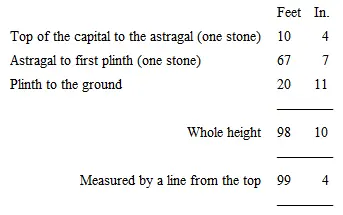
It will be remembered, however, that the pedestal of the column does not rest on the ground,
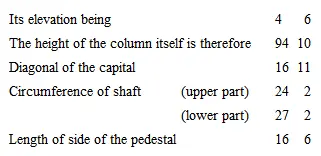
Shaw says, that in his time, in expectation of finding a large treasure buried underneath, a great part of the foundation, consisting of several fragments of different sorts of stone and marble, had been removed; so that the whole fabric rested upon a block of white marble scarcely two yards square, which, upon touching it with a key, sounded like a bell.
Читать дальшеИнтервал:
Закладка:
Похожие книги на «Ruins of Ancient Cities (Vol. 1 of 2)»
Представляем Вашему вниманию похожие книги на «Ruins of Ancient Cities (Vol. 1 of 2)» списком для выбора. Мы отобрали схожую по названию и смыслу литературу в надежде предоставить читателям больше вариантов отыскать новые, интересные, ещё непрочитанные произведения.
Обсуждение, отзывы о книге «Ruins of Ancient Cities (Vol. 1 of 2)» и просто собственные мнения читателей. Оставьте ваши комментарии, напишите, что Вы думаете о произведении, его смысле или главных героях. Укажите что конкретно понравилось, а что нет, и почему Вы так считаете.
